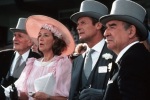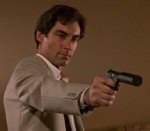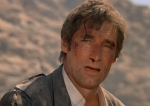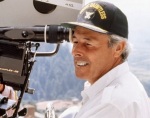The end of the Cold War, the escalation of the War on Drugs, the end of two James Bond actors’ careers, and the beginning of the modern Hollywood blockbuster are just a few world-changing events that took place under director John Glen’s watch over the Bond franchise from 1981-1989.
Terence Young and Guy Hamilton are frequently mentioned among the greatest directors of James Bond films. They helped to set the tone for the series in its formative years in the 1960s. Other directors came and went in the 1970s, but then something unprecedented occurred. For an entire decade and five straight films, one man was in charge of it all: John Glen. He is responsible for more Bond films than any other director. In fact, Sam Mendes is the first one since him to direct two in a row.
I’d like to talk about the many beginnings and endings that occurred during John Glen’s tenure and how he managed to keep the series going through so many changes.
A New Direction
Roger Moore was at the height of his popularity when John Glen came into the picture. Moore had already starred in four Bond films and had cemented his reputation as a more light-hearted adventurer than previous Bond actors. With John Glen’s first film, he needed to set a new tone for the series to ground it after the previous film Moonraker had taken the series into outer space.
 John Glen accomplished this by doing two things in the precredit scene of For Your Eyes Only. James Bond visits the grave of his dead wife (who he had married in a previous film) and kills Blofeld, the man responsible for his wife’s death. It was a nice nod to previous films while making it clear that this film was putting a rest to some of those earlier conventions to make room for a new take on the character.
John Glen accomplished this by doing two things in the precredit scene of For Your Eyes Only. James Bond visits the grave of his dead wife (who he had married in a previous film) and kills Blofeld, the man responsible for his wife’s death. It was a nice nod to previous films while making it clear that this film was putting a rest to some of those earlier conventions to make room for a new take on the character.
The rest of the film is noticeably devoid of gimmicks and gadgets. Bond relies on his wits and skills to defeat his enemies. As a side note, the character M does not appear in this film because actor Bernard Lee died after filming Moonraker.
Indiana Bond
 Octopussy is the most comical of John Glen’s Bond films. It seems to be taking its cues from Raiders of the Lost Ark with its jungle setting and other details. This film brought back actress Maud Adams nine years after her role in The Man with the Golden Gun. That was the first and last time the series brought back an old Bond girl to star in a new adventure. M returns, this time played by Robert Brown, who had played a different character in The Spy Who Loved Me. He would play M in the next three Bond films, as well. The film also tried to introduce an assistant for the Moneypenny character, but she never appeared in any other films, so if she was meant to be Monneypenny’s replacement, that idea never went anywhere.
Octopussy is the most comical of John Glen’s Bond films. It seems to be taking its cues from Raiders of the Lost Ark with its jungle setting and other details. This film brought back actress Maud Adams nine years after her role in The Man with the Golden Gun. That was the first and last time the series brought back an old Bond girl to star in a new adventure. M returns, this time played by Robert Brown, who had played a different character in The Spy Who Loved Me. He would play M in the next three Bond films, as well. The film also tried to introduce an assistant for the Moneypenny character, but she never appeared in any other films, so if she was meant to be Monneypenny’s replacement, that idea never went anywhere.
Bittersweet Swan Song
 A View to a Kill marked the end of two important things. It was the last Bond film to star both Roger Moore and original Moneypenny actress Lois Maxwell. It’s fitting that those two would retire together. He had starred as James Bond in more films than any other actor (which still holds true today), and she had been in more Bond films than any other actor up to that point (including Desmond Llewelyn, though he did eventually surpass her with Goldeneye). They were relics of an earlier age, and they were doing their best to keep the old magic alive, but it was clear they were both past their prime at this point.
A View to a Kill marked the end of two important things. It was the last Bond film to star both Roger Moore and original Moneypenny actress Lois Maxwell. It’s fitting that those two would retire together. He had starred as James Bond in more films than any other actor (which still holds true today), and she had been in more Bond films than any other actor up to that point (including Desmond Llewelyn, though he did eventually surpass her with Goldeneye). They were relics of an earlier age, and they were doing their best to keep the old magic alive, but it was clear they were both past their prime at this point.
One Last Cold War Thriller
The Living Daylights was the beginning and end of many things. It, of course, introduced Timothy Dalton to the role of James Bond. It reintroduced the Aston Martin brand for the first time since 1969’s On Her Majesty’s Secret Service. And it brought Joe Don Baker into the series for the first time. He would later return as a completely different character in the first two Pierce Brosnan Bond films. And a new actress was brought in to play Moneypenney for the first time in 25 years. Oh, and Barbara Broccoli was credited as an associate producer for the first time. She would later become a full producer on Goldeneye and every ensuing Bond film through Spectre and beyond.
 The Living Daylights was the final Cold War spy movie in the series. A lot of it centers on Soviet intrigue and double-crosses. You could argue that Goldeneye covers similar territory, but that’s dealing with a post-Soviet Union Russia. The world was never the same after the Iron Curtain fell, and James Bond had to change with it. Also, this was the last Bond film scored by legendary composer John Barry. Barry had helped create the original James Bond Theme for Dr. No, and had worked on 10 other Bond films after that one. Throat surgery prevented him from working on the score for Licence to Kill, so this would have to be his farewell to the series. He did get to go out in style, though. He had his first and last cameo in this film as an orchestra conductor.
The Living Daylights was the final Cold War spy movie in the series. A lot of it centers on Soviet intrigue and double-crosses. You could argue that Goldeneye covers similar territory, but that’s dealing with a post-Soviet Union Russia. The world was never the same after the Iron Curtain fell, and James Bond had to change with it. Also, this was the last Bond film scored by legendary composer John Barry. Barry had helped create the original James Bond Theme for Dr. No, and had worked on 10 other Bond films after that one. Throat surgery prevented him from working on the score for Licence to Kill, so this would have to be his farewell to the series. He did get to go out in style, though. He had his first and last cameo in this film as an orchestra conductor.
A New Kind of Battle
Licence to Kill was the end of the road in many ways. Timothy Dalton, Robert Brown, John Glen, and Albert R. Broccoli would never return to the series for a variety of reasons. It was the only Bond film scored by the late, great Michael Kamen. This film is also notable for being the first Bond film that failed to earn back its production cost in the U.S. Worldwide, it did perfectly respectable business, but it came out right on the cusp of a new age of blockbusters. The Bond brand was no longer the big fish in a small pond. It had major competition from hugely popular franchises like Indiana Jones, Ghostbusters, and Lethal Weapon, just to name a few.
 Licence to Kill wasn’t prepared to fight this new kind of box-office battle. The modern blockbuster was single-handedly invented by 1989’s Batman, which was the first film to become a runaway hit based entirely on its omnipresent marketing tie-ins. The brand became bigger than the film itself. John Glen’s dark James Bond tale (which was the first in the series to be rated PG-13 instead of PG) just couldn’t compete with the other juggernauts that year. This forced the franchise to be retooled in the coming years to compete in an ever-changing environment.
Licence to Kill wasn’t prepared to fight this new kind of box-office battle. The modern blockbuster was single-handedly invented by 1989’s Batman, which was the first film to become a runaway hit based entirely on its omnipresent marketing tie-ins. The brand became bigger than the film itself. John Glen’s dark James Bond tale (which was the first in the series to be rated PG-13 instead of PG) just couldn’t compete with the other juggernauts that year. This forced the franchise to be retooled in the coming years to compete in an ever-changing environment.
Overseeing the End of an Era
 The disappointment of Licence to Kill at the box office made it easy for producers to part ways with its director on future projects. There were a lot of legal issues to resolve and buyouts to process in the six years between Licence to Kill and Goldeneye. But while John Glen didn’t get to go out in a blaze of glory, exactly, he did do a fine job reorienting the series through a turbulent time of great change.
The disappointment of Licence to Kill at the box office made it easy for producers to part ways with its director on future projects. There were a lot of legal issues to resolve and buyouts to process in the six years between Licence to Kill and Goldeneye. But while John Glen didn’t get to go out in a blaze of glory, exactly, he did do a fine job reorienting the series through a turbulent time of great change.
He introduced the series to a darker sensibility, tried to get back to the basics, and oversaw the end of two Bond actors. And he directed more Bond films than anyone else. He was also the first to replace old actors for the roles of M and Moneypenny, and he helped the series transition into the newly created PG-13 rating. I’d say he deserves a lot of credit for all of these accomplishments.
John Glen ruled the ‘80s, and his accomplishments still reverberate through the James Bond series to this day.
This is the Deja Reviewer bidding you farewell until we meet again.
All images are the copyright of their owners.

You and I seem to be a part of the Few and the Proud- people who actually liked Timothy Dalton’s run as Bond. As you said, those movies were darker and gritter, more in touch with the source material. Good article. Thanks.
LikeLiked by 2 people
The Proud and the Few… I like it. 🙂 The Living Daylights has long been my favorite Bond film, with Licence to Kill right up there near it. They definitely deserve a lot of respect.
LikeLiked by 1 person
I am always a bit cautious reading about this era in the Bond universe, because it is often treated very badly, but this is a very good summation of my own thoughts on the subject, and in fact would be interesting to read more about. Recently, in fact, there was a book published about this era, written by John Glen: http://www.amazon.co.uk/gp/product/0957648189/ref=s9_wish_gw_d26_g14_i6?ie=UTF8&colid=1F0Z8V45JQI84&coliid=I1CMZ00B7FR6ZN&pf_rd_m=A3P5ROKL5A1OLE&pf_rd_s=desktop-1&pf_rd_r=0KCYZVPY480BTGR7DFHZ&pf_rd_t=36701&pf_rd_p=577047927&pf_rd_i=desktop. A coincidence?
LikeLike
Man, I would love to read that book. I wanted to write a lot more about these films and John Glen, but a lot of it got cut out in the editing process. Did you know that he was a second unit director on Superman: The Movie and a second unit director and editor on several Bond films, starting with 1969’s On Her Majesty’s Secret Service? Such a cool guy and such awesome films.
LikeLiked by 1 person
I did. He is quite underappreciated, in my opinion.
LikeLike
Wow, Robert, what an outstanding report! I was a huge Bond fan as a kid in the 80s and waned in the 90s with Pierce Brosnan. The lighthearted playboy who could be tough at times, Roger Moore, was actually my favorite, but I loved Dalton in The Living Daylights, which still remains my favorite Bond movie to this day, mostly because of the love story between James and Kara and it’s the only Bond film I got to see in London. Thanks again for the flashback and the report. Great stuff!
LikeLiked by 1 person
That’s so cool! I feel the same way about The Living Daylights. It’s endlessly rewatchable. Thanks for sharing your experiences with the series. I’m so glad you liked the article.
LikeLiked by 2 people
It was extremely informative and accurate, Robert. Thank you also!
LikeLike
Great thoughts! I’m a grad student and I’m doing some research on the James Bond movie. If you could take and pass around my survey (it’s really quick: 5-10 minutes!), I’d really appreciate it!
https://www.surveymonkey.com/r/5DSK6BD
Thanks!
-jen
LikeLike
I did your survey and tried to get others to respond as well. I hope you don’t mind 🙂
LikeLike
Don’t mind at all! Thank you!
LikeLike
I’m happy to help. I took your survey. I wish you the best of luck with it.
LikeLike
Thanks! I really appreciate it!
LikeLike
Pingback: Unceremonious Ways Sequels Dump the Previous Film’s Love Interest | Deja Reviewer
I think Glen was a competent director who peaked with Octopussy. I much prefer his work as a second unit director. Those assault sequences in ON HER MAJESTY’S SECRET SERVICE and THE SPY WHO LOVED ME are the best in Bond history.
LikeLike